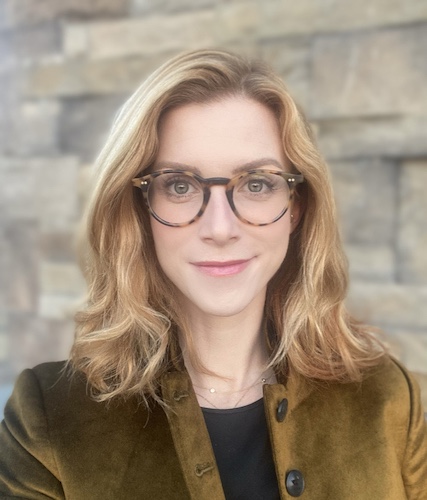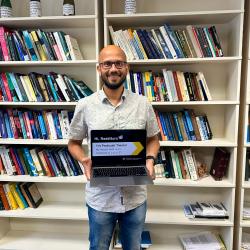Tapping Into the Power of the Brain
Through her work with startup MindX and Blackrock Neurotech, Julia Brown (B.S. ’13, biological sciences) is setting the stage for next-generation devices in health care and neurotechnology, from brain-controlled smart glasses to seizure detectors and more.
As a scientific researcher and entrepreneur, Julia Brown (B.S. ’13, biological sciences) is changing the future of health care and assistive technology by connecting with the human brain. Five years ago, Brown launched the neurotech startup MindX to develop software that combines neurotechnology, artificial intelligence (AI) and augmented reality (AR) to translate brain signals for use in medical devices and wearable technology.

We are still scratching the surface in our understanding of how information is encoded across the brain’s billions of neurons,” Brown explained, “but we have created models that can decode specific information like the movement of your hand or a small set of keywords.”
From its early days, MindX worked to build useful applications for assistive technology, such as the world’s first brain-controlled smart glasses. In 2022, the company was acquired by Blackrock Neurotech, a pioneer in implantable medical devices, becoming part of a bigger effort to custom-design innovative brain technologies to treat challenging neurological conditions and improve patients’ quality of life.
“We thought that with Blackrock there was a good opportunity to put our technology to work in a product that would improve people’s daily lives,” Brown said. “So, for example, if you’re an individual with a severe mobility impairment, you could get a Blackrock Neurotech brain implant and the MindX software running on the device will translate your brain signals and allow you to turn the lights on or call your care team just through thought.”
A goal to do good
Long before Brown started her professional career, she committed herself to one goal: to make a difference in the world. In high school, inspired by her mother, she started to gravitate toward a future in medicine.
“My mom had recently become a dietician and I spent some time in high school shadowing her anytime I could, meeting with the clinicians where she worked,” Brown recalled. “That’s when I got really excited about the potential for medicine as a future career. It’s an incredibly compelling field.”
At the University of Maryland, Brown’s decision to major in biological sciences along with support from the campus community helped her bring her dreams into focus.
“Since childhood I’ve always felt a strong sense that I should use whatever I have to do good, to create a better future for others, and at UMD I met a lot of people who crystallized that into something more practical,” Brown explained. “Biological sciences is fantastic because it provides you with so many opportunities to expose yourself to premed, to data science, to engineering, and I definitely credit the professors at UMD for helping me explore all that.”
It wasn’t just the biological sciences and computer science classes she took at UMD that sparked Brown’s interest. She also connected with work opportunities that meshed her passions for science and doing good, from a job at Ashoka where she researched funding mechanisms for health care entrepreneurs to Johns Hopkins Medicine (JHM) where her work combined therapeutics and tech. From 2012 to 2017, Brown worked with JHM’s Technology Innovation Center, developing more than two dozen digital solutions to improve medical treatments and patient care, many of which spun into independent startup ventures.
“The whole organization provided an opportunity to grow new skill sets and experiment a little bit,” she recalled. “We built chat applications that were HIPPA compliant, we built a sepsis detection and monitoring application, and one of the most fun projects was a neurotech product called EpiWatch, an epilepsy condition management application and seizure detection platform for the Apple Watch that we did in a partnership with Apple.”
Brown’s collaborators at JHM had also been working on a brain-computer interface for use in assistive medical devices and in wearable devices like smart eyeglasses, designed to access a computer by “look and think” instead of point and click. Working with scientists around the country on cutting-edge research, Brown was energized and inspired.
“I still get goosebumps”
“I remember the first time we built this software to decode a neural signal and hooked it up with a patient in a lab at Caltech—our technology was very simplistic, we basically just wanted to decode a series of letters or words that the patient would imagine,” she recalled. “It worked perfectly right out of the box, and that was just the coolest feeling ever. It’s hard to describe how amazing it is to watch someone control something with their mind. I still get goosebumps.”
In 2017 when Brown decided it was time to commercialize a technology, MindX was born. It was a challenge from day one.
“It’s very intense to be the CEO of a small tech company,” Brown explained. “You have to make sure you’re taking care of your team while meeting the needs of your shareholders and investors and building something worthwhile, and you learn something every single day. I absolutely enjoyed it.”
There was no shortage of interest in what MindX had to offer.
“Early on, MindX built software for large companies that wanted to see what the future might look like with brain control of a virtual reality or augmented reality system,” Brown said. “Later, we started working very closely with more medical device manufacturers, and that’s ultimately what led to our acquisition by Blackrock Neurotech.”
For Brown, joining Blackrock was the right move at the right time.
“At the time, Blackrock had a device that was working well in humans, it was very safe to use, to implant, and Neuralink, the company that Elon Musk launched, and Facebook were both pouring a ton of capital into this space as well,” Brown noted. “So we looked at that as an opportunity to provide something you could do with a brain-computer interface by creating software that could translate brain signals for use in their medical devices.”
After the acquisition, as Blackrock’s head of data strategy and AI, Brown committed herself to developing safer and more effective neurotech solutions for health care, including applications for mental wellness, assistive technology and restoring function.
“As an engineer you’re able to build something to solve a problem, and as an entrepreneur you’re able to build products to solve problems for more people,” she explained. “My personal focus now is really around AI, privacy and how do we scale our impact—not just from a technology perspective but how do we make sure we have the right kind of social and cultural guidelines in place to make sure people understand what they’re buying.”
“The sky’s the limit”
Looking to the future of neurotech, Brown sees unlimited possibilities.
“In the near term I’m really excited to better understand the brain and to create better diagnostics and treatments,” she said. “As far as the brain-computer interface side is concerned, that’s going to be very exciting in the next few years when we’re going to have the ability to really change outcomes for people with life-altering conditions like ALS and paralysis, and I definitely think the sky’s the limit.”
It's next-generation technology she’s proud to be part of.
“It’s incredibly fulfilling to work on something where I feel I’m doing good in the biological sciences,” Brown explained. “There’s a fascinating mix of really hard technical problems and the ability to advance science and advance health. It’s great to be giving back to the world in a way that I feel good about.”







